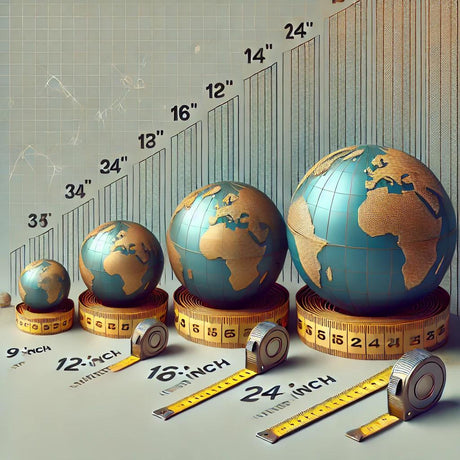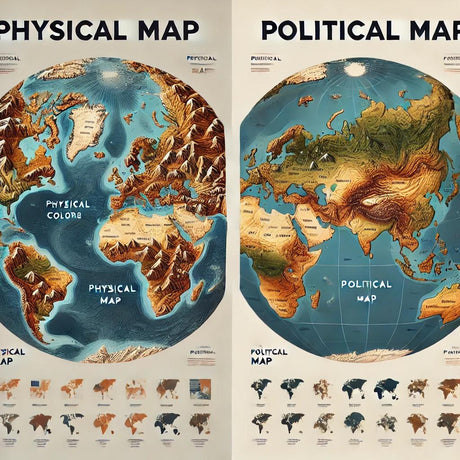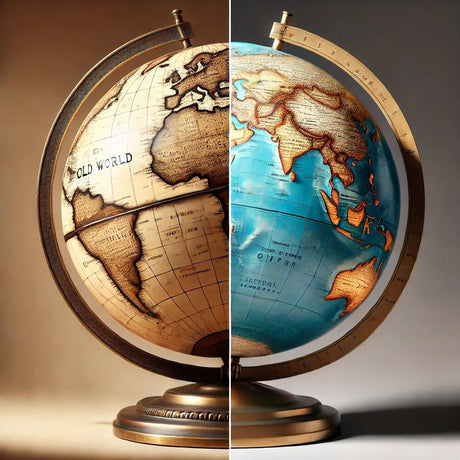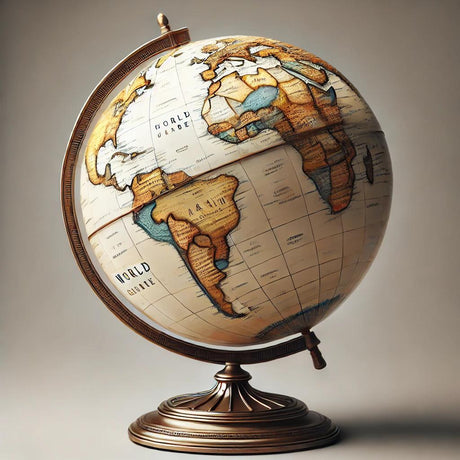A thoughtfully selected globe transforms mere information into exciting discovery, sharpening your grasp of geography while elevating your space. For globe aficionados and educators alike, navigating the vast array of terrestrial, celestial, illuminated, relief, and interactive models can feel overwhelming. This guide breaks down each globe category, explores their unique advantages and features, helps you match styles to your environment, and provides clear criteria for choosing the ideal globe. Whether you're searching for an educational gem from Ultimate Globes or a striking decorative piece, this overview will empower you to find the perfect globe for learning, decorating, or gifting.
What Are the Main Types of World Globes?
A clear classification of globe types helps buyers compare models based on their intended purpose and design. The core categories include representations of Earth's surface, mappings of the night sky, displays of political boundaries, topographical relief features, integrated illumination, and interactive learning tools. For instance, a raised relief globe offers a tactile experience of topography, while a celestial sphere model is designed to teach the fundamentals of astronomy.
- Terrestrial Globes: For accurate depictions of Earth's geography
- Celestial Globes: For charting stars and constellations
- Political Globes: For showcasing country borders and capitals
- Physical Globes: For illustrating mountains, rivers, and terrain
- Illuminated Globes: For dual day-night visualization
- Raised Relief Globes: For hands-on terrain study
- Interactive Globes: Featuring audio guides, quizzes, and AR capabilities
Each category serves distinct educational or decorative needs, leading us to explore terrestrial and celestial variations next.
An Enhanced Framework for Classifying Earth Globes
This research introduces proposed classification schemes for globes, drawing from existing map classifications and incorporating cutting-edge technologies from 2015. It points out the limited bathymetric data typically found on globes and discusses potential future advancements, especially with the increasing availability of bathymetric data and digital formats.
This academic study offers valuable insights into the classification of globes and their potential for technological evolution, resonating with our discussion of various globe types and interactive features.
What Is a Terrestrial Globe and Its Key Features?

A terrestrial globe presents Earth’s surface with current cartography, fostering geographic literacy through its accurate scale and detail. By illustrating landforms, national borders, and ocean currents, it cultivates spatial awareness and a global perspective. For example, a dual-map desk globe can toggle between political and physical views, reinforcing classroom learning.
- Features continents, oceans, and precise geographic coordinates
- Offers up-to-date cartography for current accuracy
- Integrates dual-map functionality for both political and topographical detail
This level of mapping precision sets the stage for exploring celestial sphere models that map the night sky.
How Do Celestial Globes Depict the Night Sky?
Celestial globes represent the celestial sphere by charting stars, constellations, and astronomical coordinates onto a spherical surface. This approach enhances understanding of astronomy by displaying star magnitudes and constellation boundaries as they appear from Earth. An illuminated celestial globe, for instance, emits a soft glow to highlight star patterns after dark.
- Plots constellations and star positions with accurate scale
- Indicates the celestial equator and ecliptic paths
- Includes star sizing based on magnitude for clear visual representation
Understanding this astronomical mapping leads us to compare how political and physical globes emphasize different geographical attributes.
What Distinguishes Political and Physical Globes?
Both political and physical globes are types of terrestrial models, but they serve distinct educational objectives. Political globes focus on governmental boundaries, countries, and cities to support learning in civics and international relations, while physical globes highlight natural features like mountain ranges and ocean trenches for geography studies.
| Globe Type | Displays | Emphasis |
|---|---|---|
| Political Globe | Country borders, capitals, administrative divisions | Geopolitical relationships and human geography |
| Physical Globe | Mountains, valleys, ocean depths, major rivers | Natural landforms and geological terrain |
Political models foster an understanding of human geography, preparing us to explore advanced globe features like illumination and relief.
What Are the Benefits of Illuminated and Raised Relief Globes?
Illuminated and raised relief globes combine visual appeal with tactile exploration, enhancing both educational value and decorative impact. Internal lighting illuminates map details in low-light conditions, while a textured surface invites hands-on study of elevation changes. Many students find that using illuminated relief globes to trace mountain ranges by touch reinforces memory through multi-sensory engagement.
| Feature | Description | Advantage |
|---|---|---|
| Internal Illumination | Integrated LED lighting for use in dim or nighttime settings | Boosts visibility and creates a captivating ambiance |
| Three-Dimensional Relief | Sculpted textures representing real-world elevation changes | Supports kinesthetic and tactile learning experiences |
These enhanced features transition seamlessly into the realm of interactive globe technology and engagement.
How Do Illuminated Globes Enhance Learning and Decor?

Illuminated globes utilize an internal light source to emit a gentle radiance that highlights map features regardless of ambient light. This illumination draws attention to geographic details, transforming study sessions into memorable experiences and serving as an elegant accent in any home or office. A stylish illuminated desktop globe can effortlessly transition from a classroom tool to a captivating conversation piece when the lights dim.
Illumination masterfully blends function and design by improving map legibility and cultivating an inviting atmosphere for exploration.
What Makes Raised Relief Globes Unique for Tactile Exploration?
Raised relief globes feature sculpted surfaces that accurately mimic real-world elevations, allowing users to physically feel mountain peaks and ocean trenches. This three-dimensional design promotes kinesthetic learning, helping students connect physical texture with geographic concepts like altitude and landform distribution. For example, a relief globe in a classroom can encourage learners to trace the Rockies or Himalayas with their fingertips.
Raised textures effectively bridge visual and tactile senses, deepening spatial understanding.
How Do Interactive Globes Support Learning and Engagement?
Interactive globes integrate digital features such as audio narration, built-in quizzes, and touch-sensitive zones to create deeply engaging educational experiences. These mechanisms significantly boost engagement by delivering instant facts, prompting active user participation, and supporting curriculum alignment. A touchscreen globe that quizzes students on capital cities transforms independent study into a dynamic and stimulating activity.
- Audio guides providing geographic and historical facts
- Interactive quizzes reinforcing knowledge through active recall
- Touch-activated regions offering on-demand information
Interactive tools pave the way for augmented reality enhancements that further elevate globe interaction.
Exploring the Educational Advantages of World Globes
World globes are indispensable educational tools, offering accurate three-dimensional representations of Earth that enhance spatial reasoning and comprehension of geographical features, climate zones, and global interconnections. Modern interactive globes, equipped with touchscreen technology and augmented reality, transform learning into an engaging, multi-sensory adventure for students.
This source directly corroborates the article's points regarding the educational benefits of globes, particularly emphasizing the value of both traditional and technologically advanced interactive models for learning and engagement.
What Features Do Interactive Globes Offer for Children and Educators?
Educational globes designed for classroom use often come preloaded with lesson plans, age-appropriate facts, and robust construction to withstand frequent handling. Integrated curriculum markers assist teachers in aligning activities with learning objectives, while vibrant graphics and user-friendly controls captivate young explorers. A child-friendly interactive model typically includes extensive content and intuitive interfaces to reinforce diverse geography standards.
Durable construction and curriculum integration ensure interactive globes deliver consistent, standards-aligned educational experiences.
How Does Augmented Reality Improve Globe Interaction?
Augmented reality (AR) overlays digital information onto a physical globe when viewed through a compatible application, enriching the experience with animated satellites, real-time weather patterns, and ecosystem data. This layered presentation method fosters immersive exploration, enabling students to visualize climate dynamics or tectonic plate movements within their geographical context. An AR-enabled globe breathes life into textbooks, supporting deeper concept retention through multi-modal interaction.
AR integration masterfully bridges the physical and digital realms, deepening geographic exploration.
Which Globe Styles and Sizes Are Best for Different Spaces?
Selecting the appropriate form factor ensures that a globe not only complements its surroundings but also fulfills practical requirements. Large floor globes serve as striking decorative statements in living rooms or reception areas, while desktop and bar globes are ideal for smaller spaces without compromising educational value. A globe scaled appropriately enhances both visibility and aesthetic appeal in any setting.
- Floor Globes: For grand displays and significant visual impact
- Desktop Globes: Suitable for office desks, shelves, and classrooms
- Bar Globes: Combining globe aesthetics with discreet storage solutions
Consider how each style balances spatial needs with its intended purpose before making your final selection.
What Are the Advantages of Floor Globes as Statement Pieces?
Floor globes, typically ranging from 16 to 30 inches in diameter and mounted on sturdy stands, create sculptural focal points in foyers or libraries. Their elevated placement and intricate cartography naturally draw the eye, serving as both elegant décor and practical reference tools. A polished wood floor globe can become an artistic centerpiece that sparks conversation and encourages exploration in spacious interiors.
Floor models combine impressive scale with geographic accuracy to capture attention and ignite curiosity.
Why Choose Desktop or Bar Globes for Compact Spaces?
| Style | Diameter Range | Ideal Use |
|---|---|---|
| Desktop Globe | 6–12 inches | Study desks, bookshelves, bedside tables |
| Bar Globe | 14–18 inches | Home bars, side tables, entertaining areas |
Compact globes ensure that practical learning tools and stylish decorative elements integrate seamlessly into smaller environments.
How Can You Choose the Right Globe for Your Needs?
Selecting the ideal globe involves balancing size, materials, map style, and budget to align with your intended use and décor. Consider its placement, who will be using it, and which features—such as illumination, relief texture, or interactivity—will provide the most value. For instance, educators might prioritize updatable cartography, while collectors may seek detailed relief surfaces and premium finishes.
- Size and diameter to fit the designated space
- Materials and finish for durability and aesthetic appeal
- Map style (political, physical, celestial) to match learning objectives
- Budget range aligned with desired quality and features
Clear decision-making criteria will guide you toward a globe that fulfills both practical and aesthetic goals.
What Should You Consider When Buying a Globe?
Evaluating the materials, accuracy, durability, and stand design ensures lasting satisfaction. Bases made of wood and metal offer stability, while gores made of acrylic or laminated paper guarantee scratch resistance. Updatable cartography maintains relevance as political boundaries or place names evolve. Opting for high-quality construction supports years of exploration and decorative versatility.
Superior construction and accurate mapping lay the foundation for enduring educational and decorative enjoyment.
Where Can You Find Quality Globes from Trusted Brands?
Ultimate Globes presents a carefully curated selection of premium globes from leading manufacturers, supported by expert advice and exceptional customer service. Their collection encompasses floor-standing, desktop, children's, illuminated, relief, and interactive models, each meticulously crafted for durability and accuracy. By partnering with top brands and academic institutions, Ultimate Globes ensures every purchase fuels geographic curiosity and learning.
Discovering reputable brands with proven quality instills confidence in your investment and inspires continued exploration.
Embarking on global exploration doesn't conclude with selecting a globe—it truly begins. By understanding the distinctions among terrestrial, celestial, illuminated, relief, and interactive models, you can choose an option that supports your learning objectives and enhances your living space. Consider the scale, features, and mapping style, then explore the diverse collection at Ultimate Globes to find a globe that ignites curiosity and stands the test of time.




